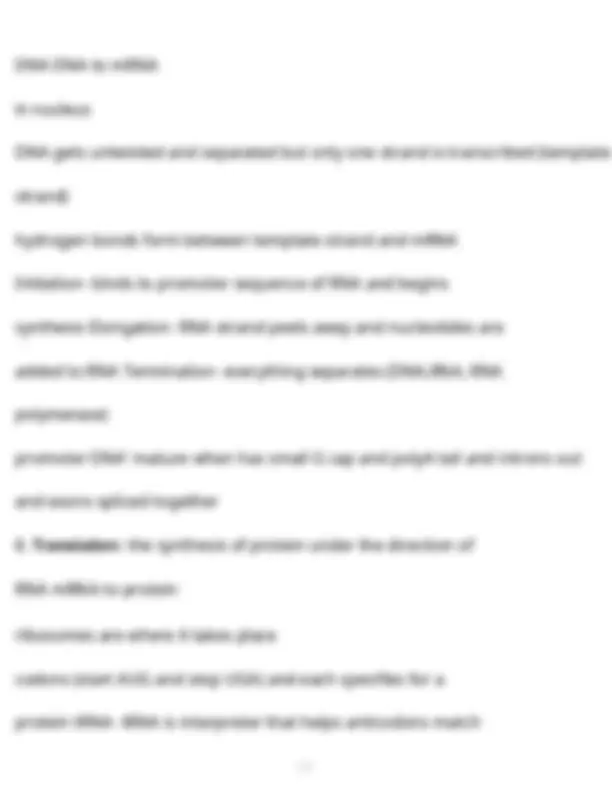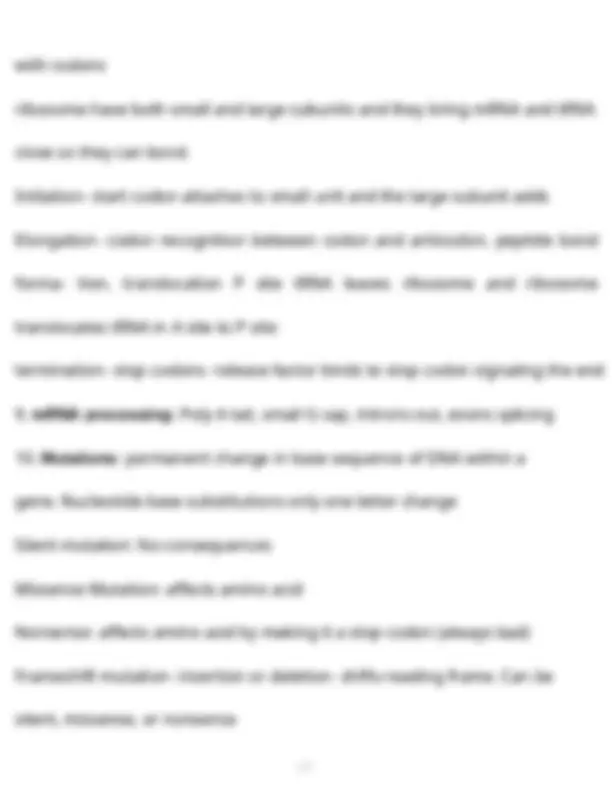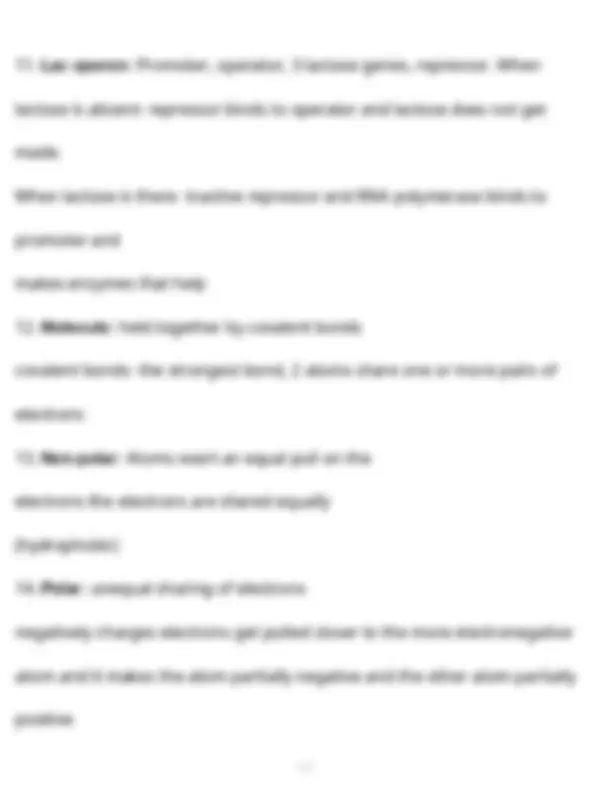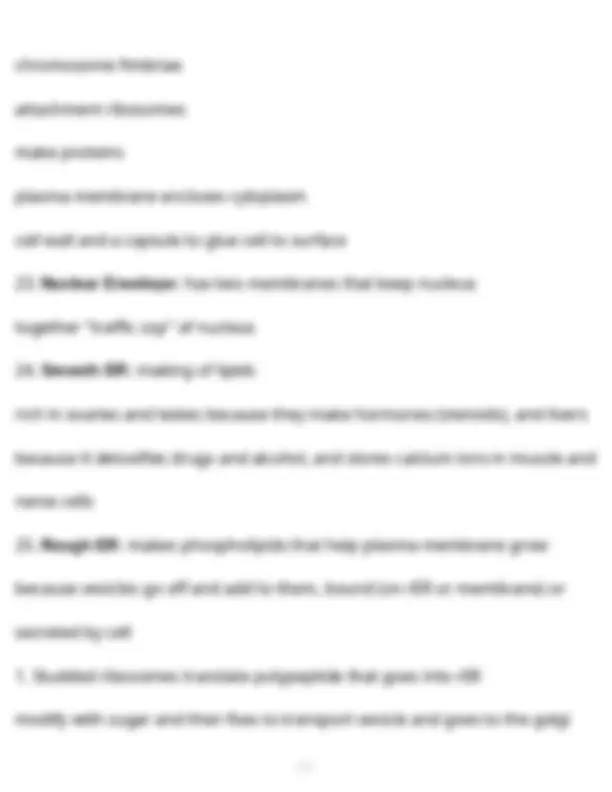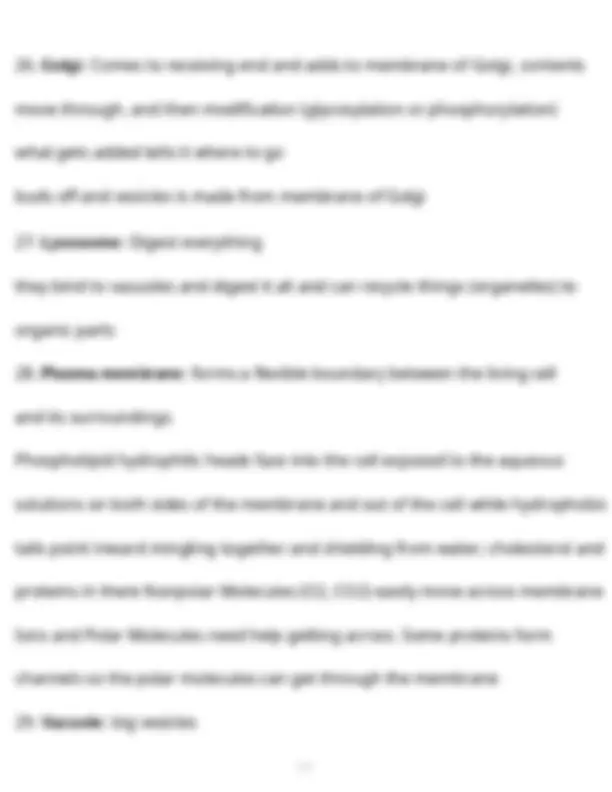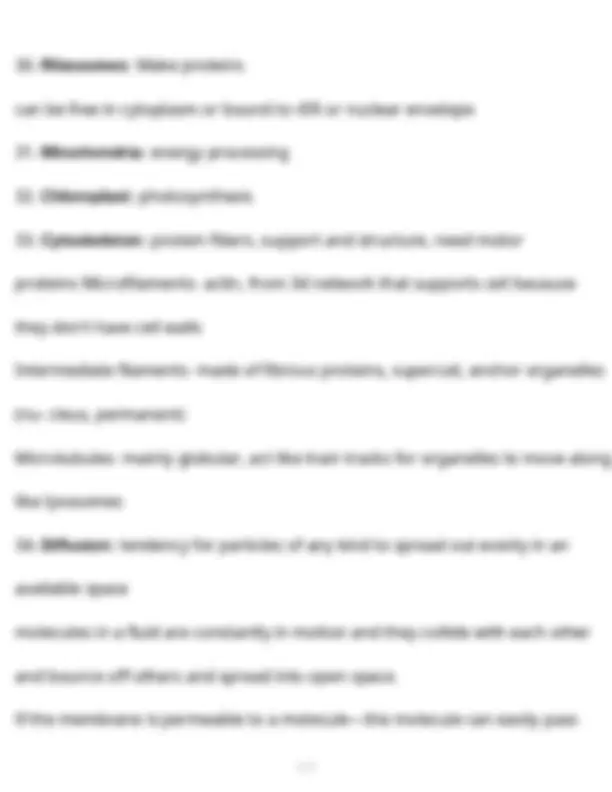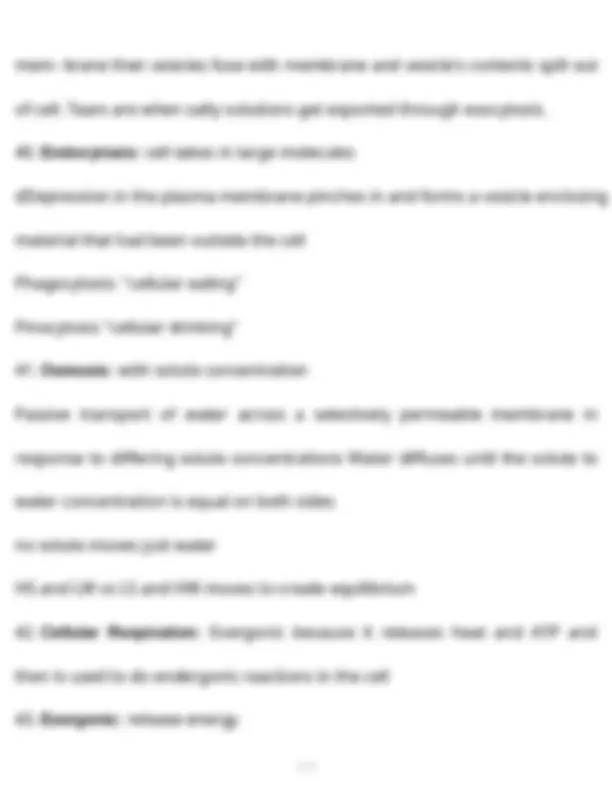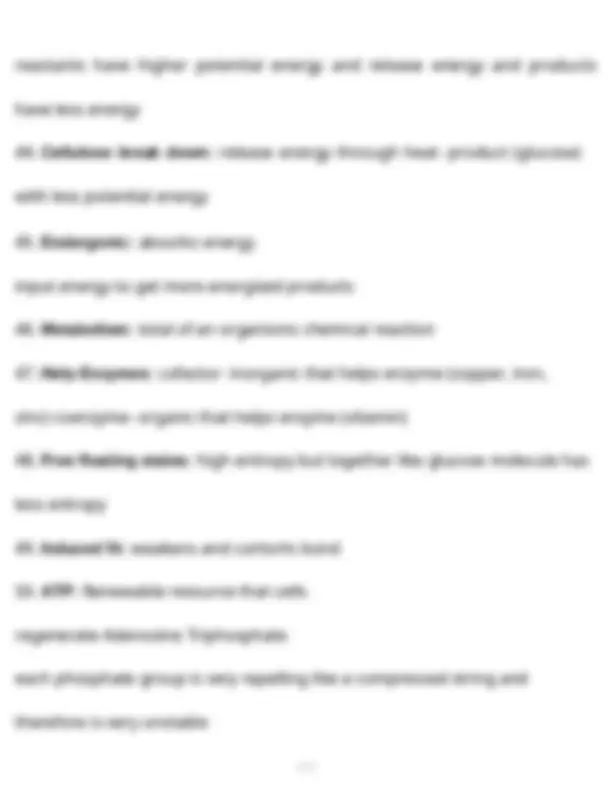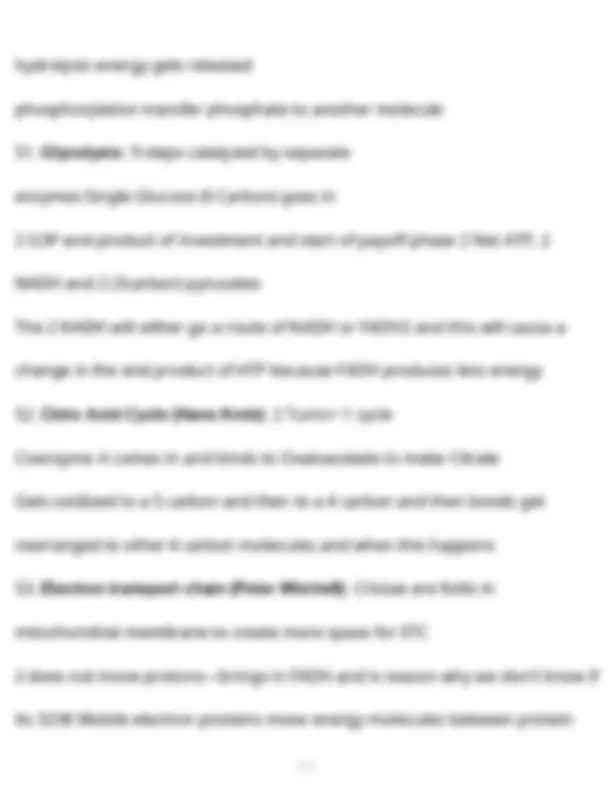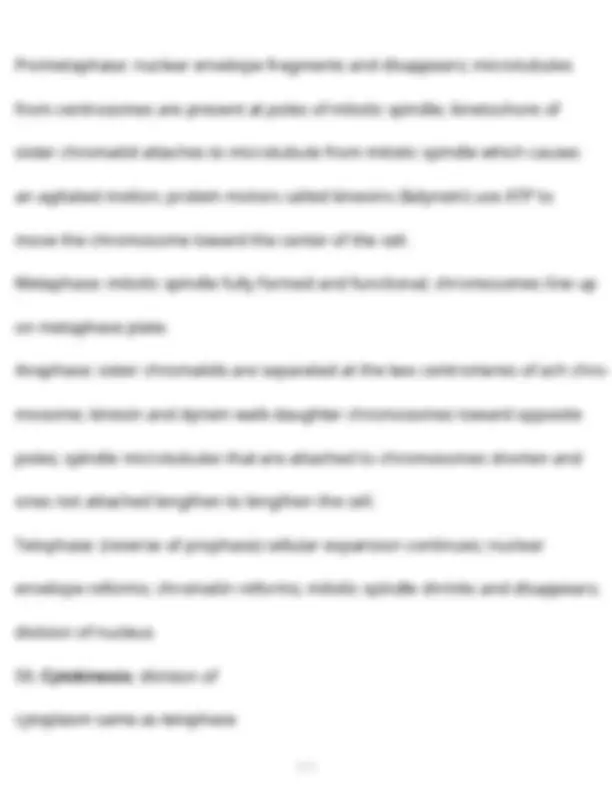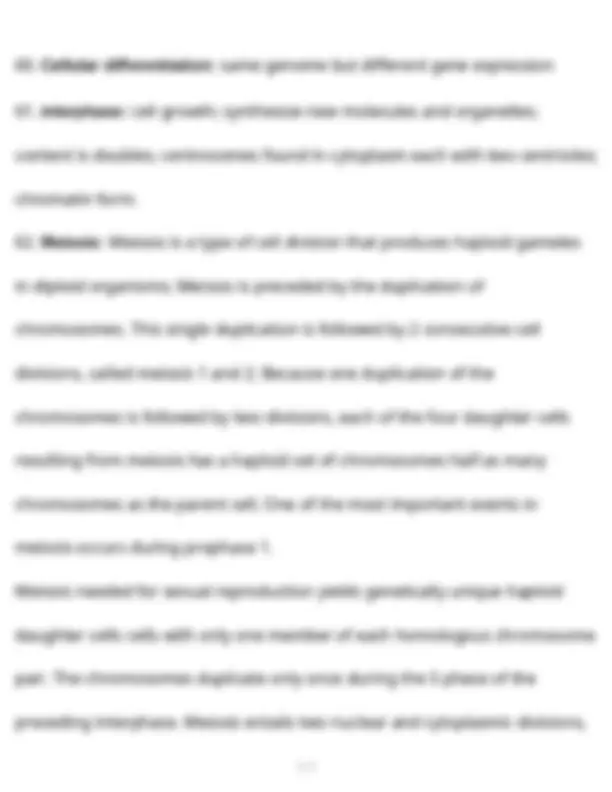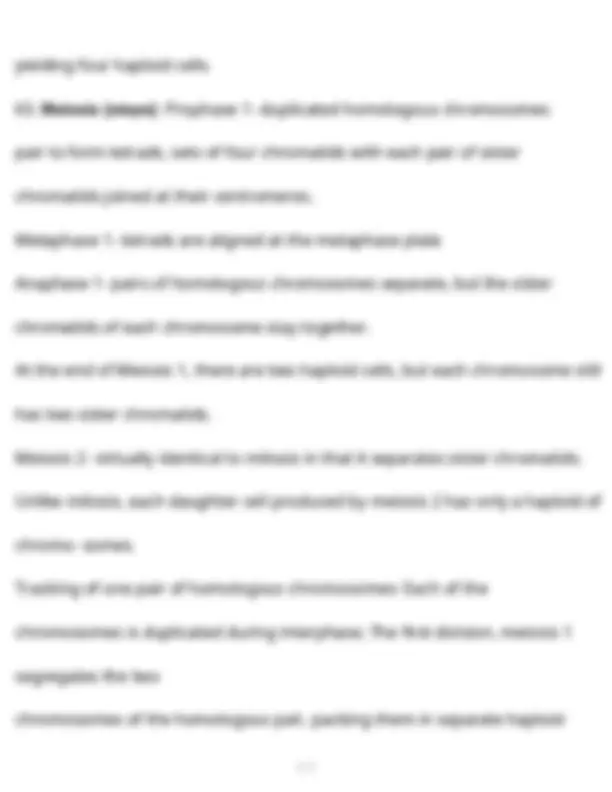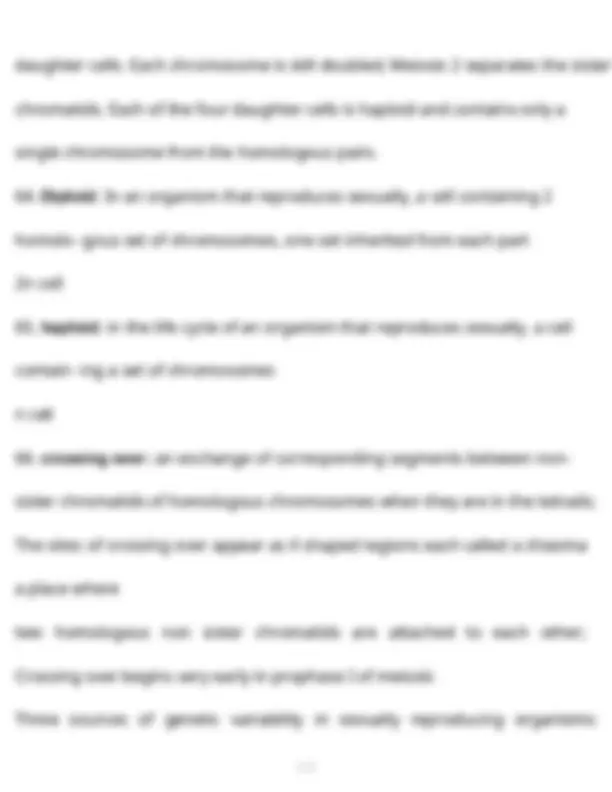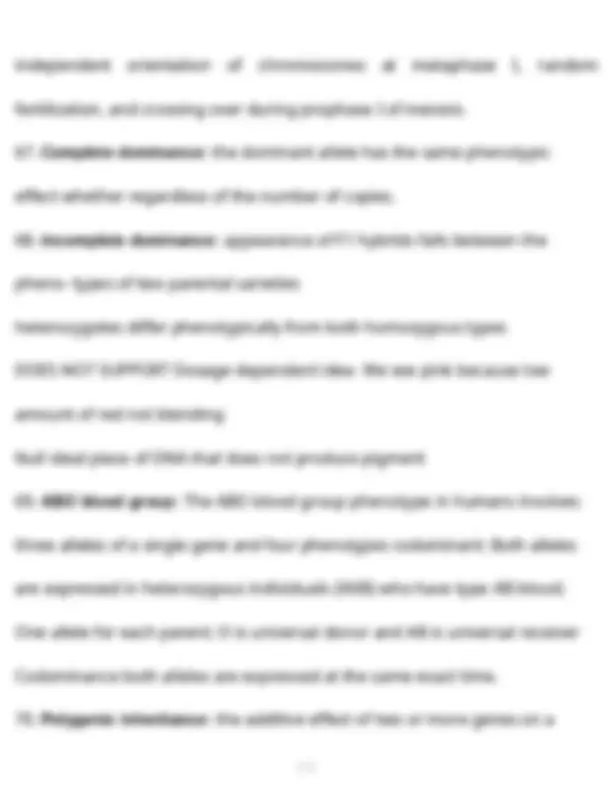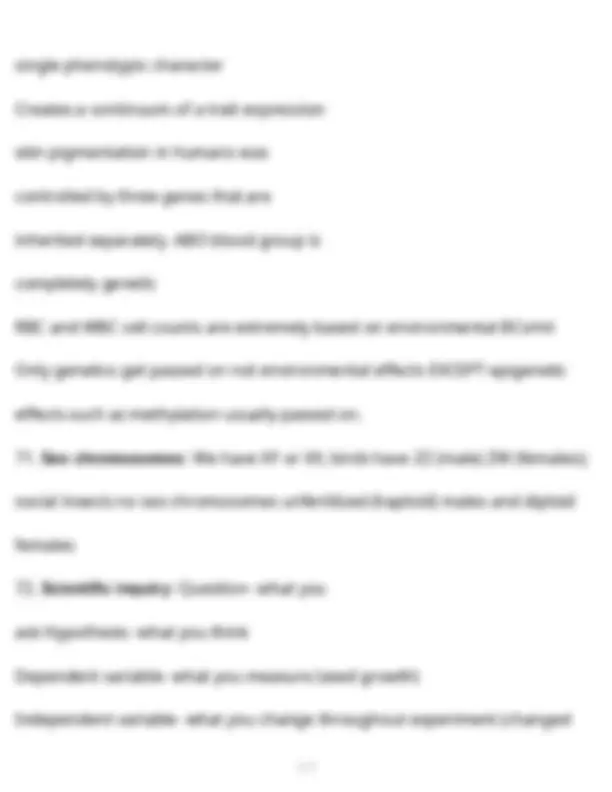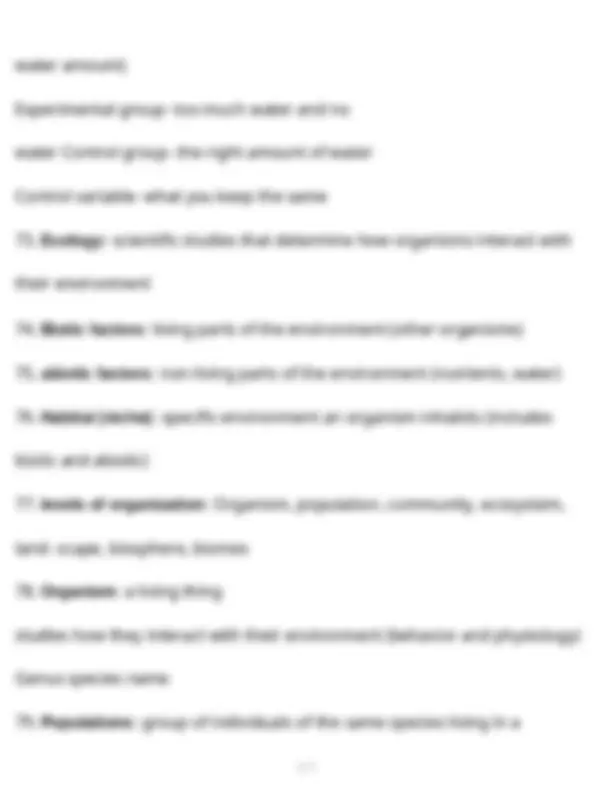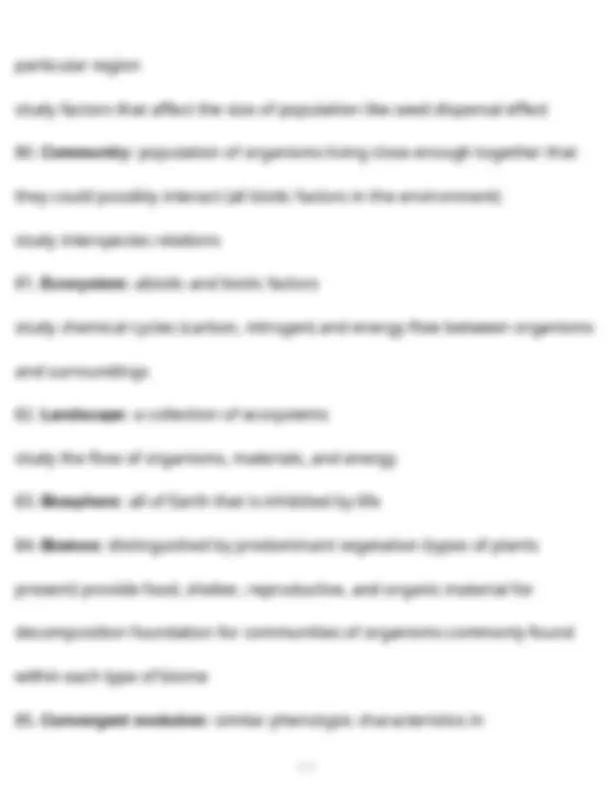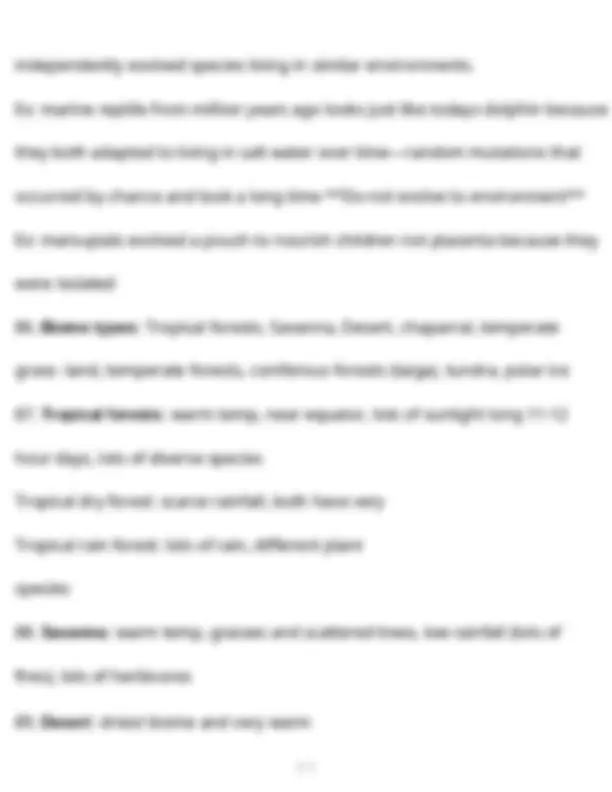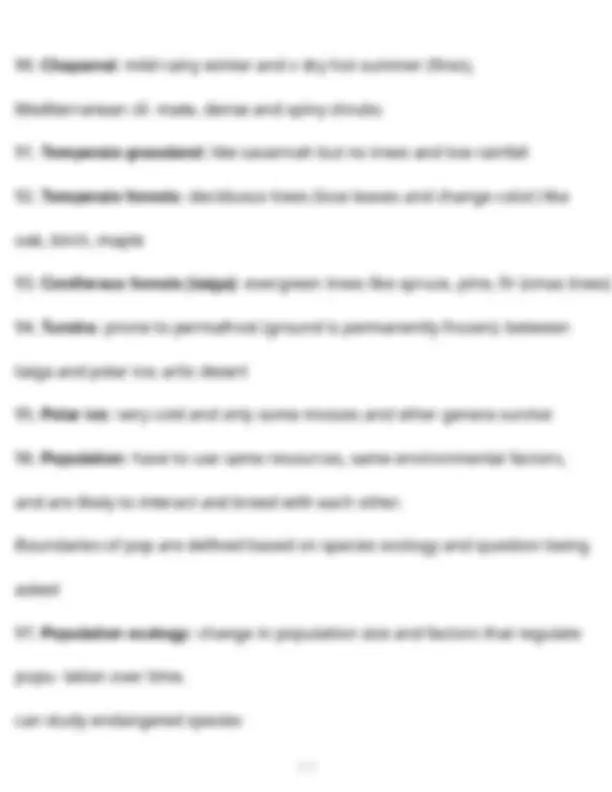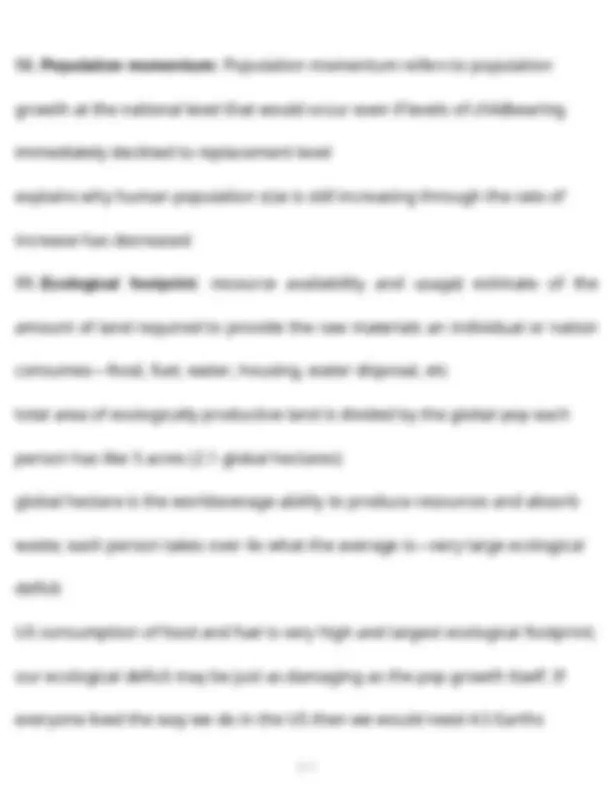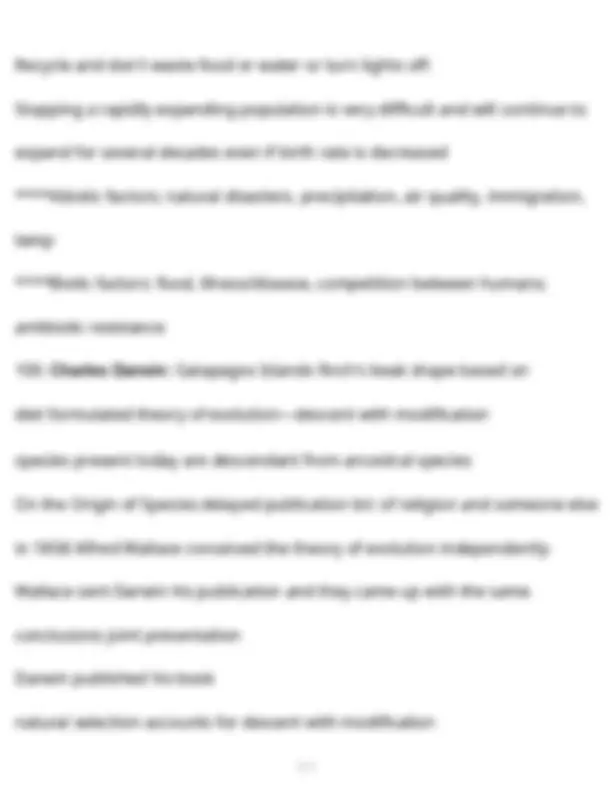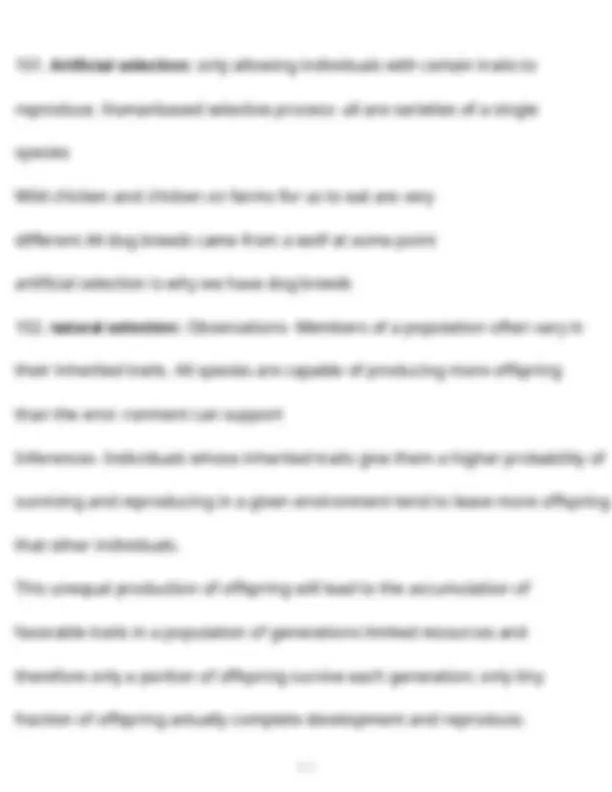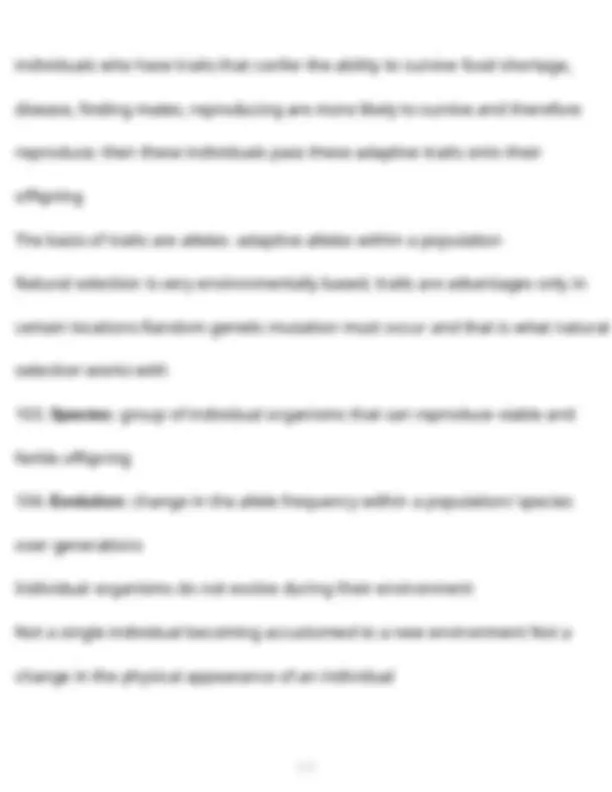Download Biology 190 Final Exam Study Guide and more Study Guides, Projects, Research Biology in PDF only on Docsity!
Biology 190 Final Exam Study Guide
- Nucleotide structure: monomers of nucleic acids every nucleotide consists of 3 parts: 5 carbon sugar, negatively charged phosphate group, nitrogenous base
- Nucleic acid: includes DNA and RNA polymer consisting of many nucleotide monomers two strands held together by hydrogen bonds
- DNA: double stranded helical nucleic acid molecule consisting of nucleotide monomers with deoxyribose sugar and nitrogenous bases A, T, C, G provides directions for its own replication sugar phosphate backbone 5' end is phosphate on carbon 5 and 3' is attached to OH group on carbon 3
- RNA: used for protein synthesis U instead of T Ribose sugar much different place than DNA singlestranded ribose has an extra oxygen and is very reactive and less stable than DNA
- DNA replication: 1 parental molecule yields 2 identical daughter DNA molecules (semiconservative) strands assembled from freefloating nucleotides and added using enzymes DNA helicase untwists DNA and makes bubbles DNA polymerase catalyzes nucleotide formation of daughter strand and proofreads DNA ligase connects growing strand leading strand is continuous and lagging is not because DNA is antiparallel
- Central Dogma: DNA is transcribed into RNA moves to nucleus RNA is translated into proteins
- Transcription: synthesis on RNA under the direction of
with codons ribosome have both small and large subunits and they bring mRNA and tRNA close so they can bond. Initiation- start codon attaches to small unit and the large subunit adds Elongation- codon recognition between codon and anticodon, peptide bond forma- tion, translocation P site tRNA leaves ribosome and ribosome translocates tRNA in A site to P site termination- stop codons- release factor binds to stop codon signaling the end
- mRNA processing: Poly A tail, small G cap, introns out, exons splicing
- Mutations: permanent change in base sequence of DNA within a gene. Nucleotide base substitutions only one letter change Silent mutation: No consequences Missense Mutation: affects amino acid Nonsense: affects amino acid by making it a stop codon (always bad) Frameshift mutation- insertion or deletion- shifts reading frame. Can be silent, missense, or nonsense
- Lac operon: Promoter, operator, 3 lactose genes, repressor. When lactose is absent- repressor binds to operator and lactose does not get made. When lactose is there- inactive repressor and RNA polymerase binds to promoter and makes enzymes that help
- Molecule: held together by covalent bonds covalent bonds- the strongest bond, 2 atoms share one or more pairs of electrons
- Non-polar: Atoms exert an equal pull on the electrons the electrons are shared equally (hydrophobic)
- Polar: unequal sharing of electrons negatively charges electrons get pulled closer to the more electronegative atom and it makes the atom partially negative and the other atom partially positive
and termites have bacteria that break it down, highly branched and bonds switch off top to bottom
- Lipids: no monomer hydrophobic fatty acid- 3 tails and glycerol. saturated- all hydrogens. unsaturated- kink (poly- many kinks in 1 tail) because of double bonds. phospholipid- 2 fatty acid tails. hydrophilic (polar) head with hydrophobic tail
- Eukaryotes: Organelles are all membrane-bound (rER, sER, ribosomes, cy- toskeleton, golgi, nucleus, mitochondria) animals only- lysosomes, centrioles / plants only- chloroplast, cell wall, plasmodesmata, central vacuole cytoskeleton provides support and mobility
- Prokaryotes: No membrane-bound organelles nucleoid is where all DNA is found only one circular
chromosome fimbriae attachment ribosomes make proteins plasma membrane encloses cytoplasm cell wall and a capsule to glue cell to surface
- Nuclear Envelope: has two membranes that keep nucleus together "traffic cop" of nucleus
- Smooth ER: making of lipids rich in ovaries and testes because they make hormones (steroids), and livers because it detoxifies drugs and alcohol, and stores calcium ions in muscle and nerve cells
- Rough ER: makes phospholipids that help plasma membrane grow because vesicles go off and add to them, bound (on rER or membrane) or secreted by cell
- Studded ribosomes translate polypeptide that goes into rER modify with sugar and then foes to transport vesicle and goes to the golgi
- Ribosomes: Make proteins can be free in cytoplasm or bound to rER or nuclear envelope
- Mitochondria: energy processing
- Chloroplast: photosynthesis
- Cytoskeleton: protein fibers, support and structure, need motor proteins Microfilaments- actin, from 3d network that supports cell because they don't have cell walls Intermediate filaments- made of fibrous proteins, supercoil, anchor organelles (nu- cleus, permanent) Microtubules- mainly globular, act like train tracks for organelles to move along like lysosomes
- Diffusion: tendency for particles of any kind to spread out evenly in an available space molecules in a fluid are constantly in motion and they collide with each other and bounce off others and spread into open space. If the membrane is permeable to a molecule—the molecule can easily pass
through membrane Equilibrium: when the number of molecules moving in one direction is equal to the number of molecules moving in the opposite direction. Concentration Gradient: substances tend to move from areas of high concentration (where a ton of molecules are) to areas of less concentration (where fewer are)
- Passive transport: Diffusion across a membrane that requires no energy (O2 and CO2 diffuse easily)
- facilitated Diffusion: passage of a substance through a specific transport pro- tein across a biological membrane down its concentration gradient. Transport proteins help substances that do not diffuse freely across membrane, without them certain substances wouldn't be able to cross membrane or would take too long & wouldn't be useful; t.proteins are specific for the substance they help No energy is used because it is a type of passive transport and works with the concentration gradient
mem- brane then vesicles fuse with membrane and vesicle's contents spill out of cell. Tears are when salty solutions get exported through exocytosis.
- Endocytosis: cell takes in large molecules dDepression in the plasma membrane pinches in and forms a vesicle enclosing material that had been outside the cell Phagocytosis: "cellular eating" Pinocytosis "cellular drinking"
- Osmosis: with solute concentration Passive transport of water across a selectively permeable membrane in response to differing solute concentrations Water diffuses until the solute to water concentration is equal on both sides no solute moves just water HS and LW vs LS and HW moves to create equilibrium
- Cellular Respiration: Exergonic because it releases heat and ATP and then is used to do endergonic reactions in the cell
- Exergonic: release energy
reactants have higher potential energy and release energy and products have less energy
- Cellulose break down: release energy through heat- product (glucose) with less potential energy
- Endergonic: absorbs energy input energy to get more energized products
- Metabolism: total of an organisms chemical reaction
- Help Enzymes: cofactor- inorganic that helps enzyme (copper, iron, zinc) coenzyme- organic that helps enzyme (vitamin)
- Free floating states: high entropy but together like glucose molecule has less entropy
- Induced fit: weakens and contorts bond
- ATP: Renewable resource that cells regenerate Adenosine Triphosphate each phosphate group is very repelling like a compressed string and therefore is very unstable
systems Carrier molecules in each protein Electrons transported and Hydrogen ions or protons pumped out and create gradient bc they are charged and cannot get through on their own
- Chemiosmosis: ATP Synthase is protein that pumps H+ through which synthe- sizes ATP About 28 ATP made FADH then it would be less than 28
- ATP production: Glycolysis- 2 NADH, 2 ATP Pyruvate oxidation- 2 NADH ETC- 6 NADH, 2 FADH2, 2ATP Chemiosmosis- 28 ATP All ATP is made by substrate level phosphorylation or oxidative
- Chromosomes: chromatin- long thin fibers of DNA that is in a loose state; can be used to make macromolecules because it is not tightly wound. When cell begins to divide the DNA coils and twists to form the tight chromosomes & it does this so that DNA can be easily moved and divided. When chromatin coils up histones help to pack the DNA and also have a huge
job in gene regulation. The more tightly wound the DNA the more difficult it is to get information when it is in chromosomal form.
- Cell Cycle: The cell cycle- an orderly sequence of events that extends from the time a cell is first formed from a dividing parent until its own division into two cells Growing phase [G1, S (duplicated chromosomes), G2]- cell metabolic activity is very high and many things occur inside the cell; 90% of cells life; cytoplasm is produced; protein and organelle production is high. Cellular division (M)- Mitosis DNA divides and is evenly distributed between cells; unique to eukaryotes Cytokinesis- cytoplasmic division
- Mitosis: equal division of nucleus into 2 genetically identical daughter nuclei Interphase: cell growth; synthesize new molecules and organelles; content is dou- bles; centrosomes found in cytoplasm each with two centrioles; chromatin form. Prophase: discrete chromosomes 2 identical sister chromatids; mitotic spindle be- gins to form; microtubules grow out of centrosomes; centrosomes move away from each other.
- Cellular differentiation: same genome but different gene expression
- interphase: cell growth; synthesize new molecules and organelles; content is doubles; centrosomes found in cytoplasm each with two centrioles; chromatin form.
- Meiosis: Meiosis is a type of cell division that produces haploid gametes in diploid organisms; Meiosis is preceded by the duplication of chromosomes. This single duplication is followed by 2 consecutive cell divisions, called meiosis 1 and 2; Because one duplication of the chromosomes is followed by two divisions, each of the four daughter cells resulting from meiosis has a haploid set of chromosomes half as many chromosomes as the parent cell; One of the most important events in meiosis occurs during prophase 1. Meiosis needed for sexual reproduction yields genetically unique haploid daughter cells cells with only one member of each homologous chromosome pair. The chromosomes duplicate only once during the S phase of the preceding interphase. Meiosis entails two nuclear and cytoplasmic divisions,
yielding four haploid cells.
- Meiosis (steps): Prophase 1- duplicated homologous chromosomes pair to form tetrads, sets of four chromatids with each pair of sister chromatids joined at their centromeres. Metaphase 1- tetrads are aligned at the metaphase plate Anaphase 1- pairs of homologous chromosomes separate, but the sister chromatids of each chromosome stay together. At the end of Meiosis 1, there are two haploid cells, but each chromosome still has two sister chromatids. Meiosis 2- virtually identical to mitosis in that it separates sister chromatids. Unlike mitosis, each daughter cell produced by meiosis 2 has only a haploid of chromo- somes. Tracking of one pair of homologous chromosomes: Each of the chromosomes is duplicated during interphase; The first division, meiosis 1 segregates the two chromosomes of the homologous pair, packing them in separate haploid

